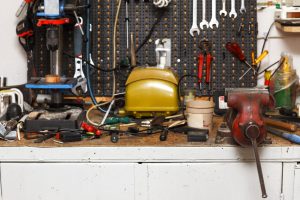We may receive a commission when you use our affiliate links. However, this does not impact our recommendations.

Editor’s note: It’s not too late to sign up for “Super Small Shop Strategies” – login and learn on your own schedule!
Years ago, while walking the halls of the offices where I worked I saw Frank at his desk, feet up, chair reclined, gazing out the window. I asked, “Aren’t you supposed to be working on that presentation you have to give tomorrow?” He said, “I am.”
Frank explained that sitting at his computer cranking out PowerPoint slides would be pointless. He needed to first pre-visualize the presentation, exactly what message he was trying to convey, the order of the presentation, what facts were important, what were not. “By doing that,” he said, “I won’t be working aimlessly, I won’t waste time, and I won’t make any slides I don’t need or miss an important detail.”
That “pre-visualization” lesson stuck with me. Before we ever start a woodworking project, pre-visualizing the steps saves time, money, and frustration. It is important for every woodworker to think through a project, beginning to end, before ever starting… but for woodworkers working in a super small woodshop, it is absolutely critical.
Small shops present unique challenges, but there is no reason we can’t make big projects in small spaces… we just have to plan the steps carefully, think everything through… pre-visualize.
In a larger shop with mostly fixed and immobile equipment, we can take project parts from machine to machine, work station to work station. In a small shop we need to be able to take the tools to the project, so to speak. In a large shop work can follow a progression… raw wood, surfaced wood, rough sized, finished size, joinery formed, glue-up, finishing. In a small shop some steps may have to be done in a different order, at different times, or even in a different place in order to make the space work for us. In a super small shop, our pre-visualization exercise may reveal potential obstacles, and it is far easier to work out how to overcome and accomplish those tasks before we start work.
Pre-visualization also helps small shop dwellers reconfigure workspaces for maximum efficiency at each stage of a project. If we need to move a machine or bench, pre-visualization will likely save multiple rearrangements and disruptions to the workflow.
Pre-visualization is just one of many techniques we will cover in the upcoming new class “Super Small Shop Strategies.” In this class we are not focused so much on tools and shop fixtures designed for smaller workspaces, but instead on big ideas, strategies, and work practices that will help make even the tiniest shop more functional and feel more spacious.
Could you make a king size four-poster canopied bed in a 10 X 10 shop? A full set of kitchen cabinets? A swing set? A large chest of drawers? The answer is yes! I hope you can join us for “Super Small Shop Strategies,” a new Popular Woodworking University multi-part class.
Here are some supplies and tools we find essential in our everyday work around the shop. We may receive a commission from sales referred by our links; however, we have carefully selected these products for their usefulness and quality.









I’m going to ignore the ‘pre-visualize’ expression; I get the concept trying to be conveyed. 🙂
Visualization has been a tool of mine for many years. I read about a study where athletes were told to visualize their success before practicing versus the control group that just practised. The visualizers did remarkably better than the control. I internalized that lesson quickly. Enough about me and seven traits of cheese moving. The take away is that visualization really does work, after all, you already did it once quite well in your head.